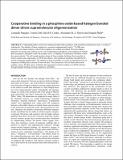Files in this item
Cooperative binding in a phosphine oxide-based halogen bonded dimer drives supramolecular oligomerization
Item metadata
| dc.contributor.author | Maugeri, Leonardo | |
| dc.contributor.author | Lebl, Tomas | |
| dc.contributor.author | Cordes, David Bradford | |
| dc.contributor.author | Slawin, Alexandra Martha Zoya | |
| dc.contributor.author | Philp, Douglas | |
| dc.date.accessioned | 2018-01-21T00:31:49Z | |
| dc.date.available | 2018-01-21T00:31:49Z | |
| dc.date.issued | 2017-02-17 | |
| dc.identifier | 249500204 | |
| dc.identifier | a9a7e39d-f9e4-4eaa-a837-90f350e40500 | |
| dc.identifier | 85013155683 | |
| dc.identifier | 000394736000015 | |
| dc.identifier.citation | Maugeri , L , Lebl , T , Cordes , D B , Slawin , A M Z & Philp , D 2017 , ' Cooperative binding in a phosphine oxide-based halogen bonded dimer drives supramolecular oligomerization ' , The Journal of Organic Chemistry , vol. 82 , no. 4 , pp. 1986–1995 . https://doi.org/10.1021/acs.joc.6b02822 | en |
| dc.identifier.issn | 0022-3263 | |
| dc.identifier.other | ORCID: /0000-0002-0269-3221/work/48131697 | |
| dc.identifier.other | ORCID: /0000-0002-5366-9168/work/32706766 | |
| dc.identifier.other | ORCID: /0000-0002-9198-4302/work/56639220 | |
| dc.identifier.other | ORCID: /0000-0002-9527-6418/work/56861338 | |
| dc.identifier.uri | https://hdl.handle.net/10023/12545 | |
| dc.description | The authors thank the Marie Curie Initial Training Network on Replication and Adaption in Networks (ReAd) for financial support (early stage researcher funding to L.M.). | en |
| dc.description.abstract | Triphenylphosphine oxide forms halogen-bonded (XB) complexes with pentafluoroiodobenzene and a 1,4-diaryl-5-iodotriazole. The stability of these complexes is assessed computationally and by 31P NMR spectroscopy in d8-toluene solution, where both complexes are weakly associated. This knowledge is applied to the design and synthesis of two self-complementary phosphine oxide-iodotriazole hybrids that incorporate a phosphine oxide XB acceptor and a 1,4-diphenyl-5-iodotriazole XB donor within the same molecule. The self-complementary design of these modules facilitates their assembly in both d8-toluene and, surprisingly, d2-DCM into dimers, with significant stabilities, through the formation of halogen-bonded diads. The stability of these assemblies is a result of significant levels of cooperative binding that is present in both solvents. The connection of two of these hybrid units together, using a flexible spacer, facilitates the aggregation of these modules in d2-DCM solution, through halogen bonding, forming oligomeric assemblies. | |
| dc.format.extent | 10 | |
| dc.format.extent | 7099605 | |
| dc.language.iso | eng | |
| dc.relation.ispartof | The Journal of Organic Chemistry | en |
| dc.subject | QD Chemistry | en |
| dc.subject | DAS | en |
| dc.subject.lcc | QD | en |
| dc.title | Cooperative binding in a phosphine oxide-based halogen bonded dimer drives supramolecular oligomerization | en |
| dc.type | Journal article | en |
| dc.contributor.sponsor | European Commission | en |
| dc.contributor.institution | University of St Andrews. School of Chemistry | en |
| dc.contributor.institution | University of St Andrews. EaSTCHEM | en |
| dc.contributor.institution | University of St Andrews. Biomedical Sciences Research Complex | en |
| dc.identifier.doi | https://doi.org/10.1021/acs.joc.6b02822 | |
| dc.description.status | Peer reviewed | en |
| dc.date.embargoedUntil | 2018-01-20 | |
| dc.identifier.url | http://pubs.acs.org/doi/suppl/10.1021/acs.joc.6b02822 | en |
| dc.identifier.grantnumber | 289723 | en |
This item appears in the following Collection(s)
Items in the St Andrews Research Repository are protected by copyright, with all rights reserved, unless otherwise indicated.

